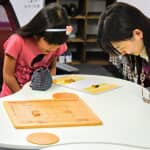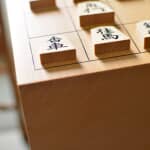2 December 2016
Five Effective Steps for Replaying an Informative Game
There are three typical Shogi learning methods; Tsumeshogi or Mate problem, Actual game, and Kifu Narabe or replaying informative games.

Representative methods of learning Shogi: Tsumeshogi or Mate problem, Actual game, and Kifunarabe or replaying informative games.
You may think two of these three, checkmate problems and actual games, are easy for beginners to enjoy. Meanwhile, you are likely to keep a distance from Kifu Narabe, thinking it difficult, tiresome, or something with nothing to go on.
Kifu Narabe is to replay a game matched by professional players, usually strong players, according to the notation of the game. It is very important for those who seriously learn Shogi and have a desire to improve their skills. Even so, it might not strongly appeal to beginners.
To make it appealing to beginners, I am presenting important points to enjoy Kifu Narabe, having them in five steps .

Let’s try Kifu Narabe with a clear purpose.
You must be far more motivated to do Kifu Narabe when you have a clear purpose.
Incidentally, I did it often as preparation to become a professional Shogi player and now realize that it is indispensable to improve Shogi techniques. Surely, it is worthy to try this, so stop hesitating!
Level 1: Take It Easy! Enjoy Placing Pieces with a Notation
If you know something about Kifu Narabe, the word of Kifu Narabe might give you an image of a very formal situation in which people with stern looks replicate a game silently.
Probably, this image could be one reason Kifu Narabe doesn’t appeal to many people. I have done it countless times, but some children and parents who just want to enjoy Shogi as a hobby and don’t have a goal to become a professional player might question its needs.
There is no need to worry. As you know, with the development of IT technology, you can enjoy Kifu Narabe online today.
It is very handy; first, put the name of a game, such as Meijin, Ouza, or Ryuou, etc., on your search engine. Visit their official website and find Shogi game notations. Replay a game with the notation, clicking on your PC or Smartphone.
If you think Kifu Narabe is something difficult or time-consuming, just give it a try. It’s important to take it easy and enjoy it!
In the beginning, you don’t need to replay a whole game at a time, but you can divide a game into several parts and do one part each time.
Level 2: Replay a whole Game
When you go to the next step, let’s place pieces according to the notation throughout the game. At first, you may feel you are off the point. However, as you practice this repeatedly, you could figure out players’ theories and maxims.
For example, you may notice that Gyoku (King) and Hisha (Rook) move in the opposite direction and remember you learned Gyoku (King) and Hisha (Rook) shouldn’t get close. You, also, may find three pieces of Kin (Gold) and Gin (Silver) are protecting Gyoku (King), or players are using pieces they have taken.
Replaying moves of a whole game, you can have the entire picture of the game. A Shogi game can be divided into three phases. The first is that you create formation to protect Gyoku (King) safe and prepare to have attacking pieces. (For details, refer to “Shogi Lesson Book for Beginners Vol. 3“) The next, your Fu (Pawn) will come up against your opponent’s Fu (Pawn). Attacking and defending, the game is getting heated. And at the final, you focus on giving checkmate. In this phase, nothing is more important than speed.
Grasping where you are in a game is one of very important factors to improve your Shogi skills.
Level 3: Place Pieces through Professional Player’s Eyes

Pretending to be a professional player who you most admire, let’s move pieces.
I know a very strong amateur player, who has collected game notations played by Meijin Habu and replicates only Habu’s moves. His strong adoration to Meijin Habu motivated him to enjoy doing Kifu Narabe.
When you practice Kifu Narabe, basically, you use a game notation done by someone superior to you. The good point of using a professional game of your favorite player is that you can master his/her feature, special skills, and winning strategies. They could become your muscle memories.
When you replay a game played by your favorite player, empathizing with him/her could help you understand his/ her psychological states.
By replaying your hero’s/heroine’s game, you probably become to want to win a game in the same ways as his/her ones, which is to be a good motivation to create your own tactical plans.
Level 4: Place a Piece Considering the Next Move

Think out what your next move will be.
So far, I have introduced the way to enjoy practicing Kifu Narabe. It is just to replay a game based on the game notation without thinking in detail.
Now, I would like to propose an advanced approach toward Kifu Narabe in which you may go on placing pieces considering your next move.
At this stage, focus on using the time to practice Kifu Narabe. I would like to recommend that you replay a game thinking about what your next move will be.
Professional players play a game always seeking the best move among hundreds of strategies.
Aside from the situation when you are about to checkmate, the wider the range you need to consider is, the harder it is to find the best one. In the worst case, the move you choose turns out to be the worst one to ruin your previous efforts and make you lose a game.
In any situation, it is really important to figure out what the best next move is.
Recommendable practice to think about the next move is using Shogi articles published in the Japanese newspaper. Some Japanese newspapers carry reviews of a major Title Shogi Match, serializing them for about 10 days. Each newspaper company deals with different title matches. If you have a chance to be in Japan, please find one for you.

Incidentally, the caution that you need to have when you decide your next move is not to do it seriously. There is no wonder that yours differ from the ones in the newspaper. A casual try is fine. Even though this is a very effective practice to improve your Shogi skills, if it makes you lose your motivation, it would prevent your continuity. Simply, try with fun!
Level 5: Feel Realistic and Watch a Game Notation Uploaded in Real-Time
Once you get used to thinking about the next move, you may go to the next step; observe the game notations uploaded in real-time (on the day when an actual game is played, each move is uploaded online in real-time).
The advantage of watching a game notation on a real-time basis is to know not only what each move was but also how long one move took time.
You may wonder why this player needed the time this long in this situation, or what else is the alternative for this player. You can apply things and feelings that the players are experiencing to your own experience.
By the way, in this level 5 unlike levels 1 to 4, I used the word, “viewing” instead of “replaying” purposely.
Some of you might feel strange about the word, “viewing”, since a proper way to replay a game is originally done on a real board. I am not good at placing pieces on a PC screen. When it comes to “replaying a game”, I need to have a real board. However, today, I assume not a few people may not have problems with using PC. This is a reason that I include “viewing a notation” into a category of “replaying a game.”
What do you think of today’s topic?
You can start things in Level 1, but to be honest, you may need some time to be ready for level 5.
Please don’t rush and stay relaxed. Getting used to this practice, you can improve your skills. Easy does it!
For further information about how to read a Kifu notation, you can learn in our textbook, “Shogi Lesson Book for Beginners Vol. 2: After Learning Moves and Basic Rules“.


